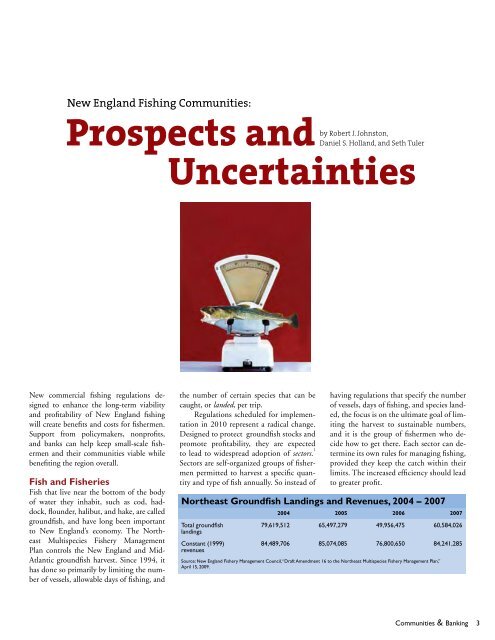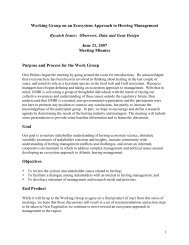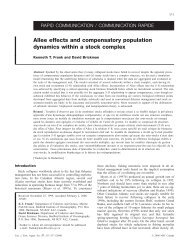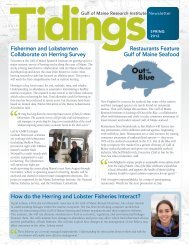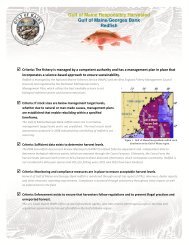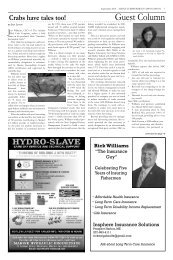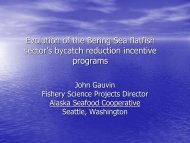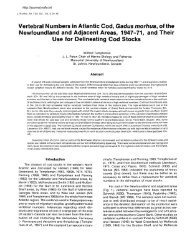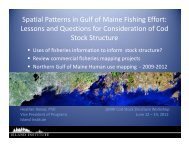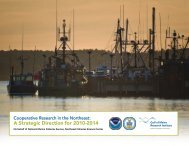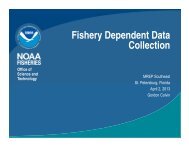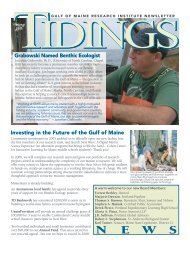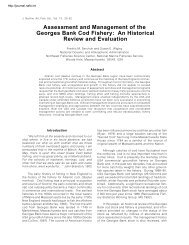New England Fishing Communities - The Federal Reserve Bank of ...
New England Fishing Communities - The Federal Reserve Bank of ...
New England Fishing Communities - The Federal Reserve Bank of ...
Create successful ePaper yourself
Turn your PDF publications into a flip-book with our unique Google optimized e-Paper software.
<strong>New</strong> <strong>England</strong> <strong>Fishing</strong> <strong>Communities</strong>:<br />
Prospects and<br />
by Robert J. Johnston,<br />
Daniel S. Holland, and Seth Tuler<br />
Uncertainties<br />
<strong>New</strong> commercial fishing regulations designed<br />
to enhance the long-term viability<br />
and pr<strong>of</strong>itability <strong>of</strong> <strong>New</strong> <strong>England</strong> fishing<br />
will create benefits and costs for fishermen.<br />
Support from policymakers, nonpr<strong>of</strong>its,<br />
and banks can help keep small-scale fishermen<br />
and their communities viable while<br />
benefiting the region overall.<br />
Fish and Fisheries<br />
Fish that live near the bottom <strong>of</strong> the body<br />
<strong>of</strong> water they inhabit, such as cod, haddock,<br />
flounder, halibut, and hake, are called<br />
groundfish, and have long been important<br />
to <strong>New</strong> <strong>England</strong>’s economy. <strong>The</strong> Northeast<br />
Multispecies Fishery Management<br />
Plan controls the <strong>New</strong> <strong>England</strong> and Mid-<br />
Atlantic groundfish harvest. Since 1994, it<br />
has done so primarily by limiting the number<br />
<strong>of</strong> vessels, allowable days <strong>of</strong> fishing, and<br />
the number <strong>of</strong> certain species that can be<br />
caught, or landed, per trip.<br />
Regulations scheduled for implementation<br />
in 2010 represent a radical change.<br />
Designed to protect groundfish stocks and<br />
promote pr<strong>of</strong>itability, they are expected<br />
to lead to widespread adoption <strong>of</strong> sectors. 1<br />
Sectors are self-organized groups <strong>of</strong> fishermen<br />
permitted to harvest a specific quantity<br />
and type <strong>of</strong> fish annually. So instead <strong>of</strong><br />
having regulations that specify the number<br />
<strong>of</strong> vessels, days <strong>of</strong> fishing, and species landed,<br />
the focus is on the ultimate goal <strong>of</strong> limiting<br />
the harvest to sustainable numbers,<br />
and it is the group <strong>of</strong> fishermen who decide<br />
how to get there. Each sector can determine<br />
its own rules for managing fishing,<br />
provided they keep the catch within their<br />
limits. <strong>The</strong> increased efficiency should lead<br />
to greater pr<strong>of</strong>it.<br />
Northeast Groundfish Landings and Revenues, 2004 – 2007<br />
Total groundfish<br />
landings<br />
Constant (1999)<br />
revenues<br />
2004 2005 2006 2007<br />
79,619,512 65,497,279 49,956,475 60,584,026<br />
84,489,706 85,074,085 76,800,650 84,241,285<br />
Source: <strong>New</strong> <strong>England</strong> Fishery Management Council, “Draft Amendment 16 to the Northeast Multispecies Fishery Management Plan,”<br />
April 15, 2009.<br />
<strong>Communities</strong> & <strong>Bank</strong>ing 3
In <strong>New</strong> <strong>England</strong>, there are two currently<br />
operating sectors, Georges <strong>Bank</strong> Cod<br />
Hook Sector and Georges <strong>Bank</strong> Cod Fixed<br />
Gear Sector, which have proposed merging.<br />
Sixteen new sectors have submitted operation<br />
plans. 2<br />
Together these sectors could be<br />
allocated more than 90 percent <strong>of</strong> the allowable<br />
commercial catch <strong>of</strong> most groundfish.<br />
Until now, most observers agree, Northeast<br />
groundfish regulations have fallen short<br />
<strong>of</strong> both biological and economic goals. Increasingly<br />
restrictive controls have stabilized<br />
some fish stocks and have increased others,<br />
with Georges <strong>Bank</strong> haddock one success.<br />
However, as <strong>of</strong> 2007, stocks were still<br />
overharvested for 15 <strong>of</strong> 19 <strong>New</strong> <strong>England</strong><br />
groundfish. From 2004 to 2007, groundfish<br />
landings declined, and inflation-adjusted<br />
gross revenues remained flat, while expenses<br />
for fuel and other inputs increased. 3<br />
(See “Northeast Groundfish Landings and<br />
Revenues, 2004 – 2007.”) In <strong>New</strong> <strong>England</strong><br />
communities experiencing the harshest<br />
effects from regulation, fishermen have<br />
consolidated, switched to other fisheries, or<br />
abandoned fishing. <strong>The</strong> number <strong>of</strong> vessels<br />
landing groundfish declined each year between<br />
2004 and 2007. (See “Vessels Landing<br />
Groundfish in Primary Ports, 2004 –<br />
2007.”)<br />
Fishery declines <strong>of</strong>ten cause fishermen<br />
and other members <strong>of</strong> their communities to<br />
undergo family stress, heavier workloads,<br />
reduced income, social tensions, and increased<br />
need for social services. 4<br />
Fishermen<br />
may delay boat repairs, skimp on safety, fish<br />
with fewer or less experienced crew, or forgo<br />
boat insurance. 5<br />
Some qualify for disaster<br />
relief funds. Others retire or shift to an activity<br />
like charter fishing. Shore businesses<br />
<strong>of</strong>ten reduce staff.<br />
Can the Sector<br />
Approach Help?<br />
<strong>The</strong> sector approach is not a panacea. Many<br />
problems facing fisheries result from an excess<br />
<strong>of</strong> boats and fishermen relative to what<br />
current fish stocks can support. For some<br />
species to recover, catches must be further<br />
reduced. Although that will likely have negative<br />
economic implications in the short<br />
run, there is a broad expectation that sectors<br />
will improve the industry’s overall performance<br />
and reduce the impetus to discard<br />
harvested fish to meet regulations (a wasteful<br />
process known as regulatory discarding).<br />
Sectors also could foster cooperation to deliver<br />
more consistent product year-round,<br />
reduce costs, and diminish negative environmental<br />
impacts.<br />
Similar harvest cooperatives in fisheries<br />
worldwide show positive results—longer<br />
seasons, increased pr<strong>of</strong>its, reduced waste,<br />
higher-quality products, and safer fishing. 6<br />
A National Research Council study <strong>of</strong> related<br />
programs concludes that allocation <strong>of</strong><br />
permits to take a portion <strong>of</strong> the allowable<br />
harvest is a “tool with high potential for efficiency<br />
and stewardship” that can help “to<br />
prevent a race for fish and overharvesting.” 7<br />
Vessels Landing Groundfish in Primary Ports, 2004 – 2007<br />
Community 2004 2005 2006 2007 2004-2007<br />
Portland, ME 111 109 94 75 -32.43%<br />
Portsmouth, NH 41 25 27 19 -53.66%<br />
Gloucester, MA 202 203 168 166 -17.82%<br />
Boston, MA 24 29 24 32 33.33%<br />
Chatham/Harwichport, MA 116 96 71 59 -49.14%<br />
<strong>New</strong> Bedford/Fairhaven, MA 182 158 153 165 -9.34%<br />
Point Judith, RI 78 75 74 76 -2.56%<br />
Eastern Long Island, NY 69 62 79 74 7.25%<br />
Total 823 757 690 666 -19.08%<br />
Source: <strong>New</strong> <strong>England</strong> Fishery Management Council, “Draft Amendment 16 to the Northeast Multispecies Fishery<br />
Management Plan,” April 15, 2009.<br />
Moreover, models <strong>of</strong> prospective community-based<br />
sectors in Portland and Port Clyde,<br />
Maine, suggest possible revenue gains <strong>of</strong> 16<br />
percent to 79 percent. 8<br />
Concerns do remain. Sectors will create<br />
new administrative costs (estimated at<br />
$60,000 to $150,000 per sector) and additional<br />
monitoring costs that the industry<br />
will have to fund. And although sectors can<br />
promote community-based fishing, consolidation<br />
could potentially lead to inequity<br />
and social tension. 9<br />
Income may be greater<br />
and more stable for some, while consolidation<br />
reduces employment overall.<br />
<strong>The</strong> Role <strong>of</strong> the<br />
<strong>Bank</strong>ing Community<br />
Whether the industry can be maintained<br />
and strengthened depends on many factors,<br />
including banking support. Access to<br />
financing with reasonable terms is critical to<br />
enable smaller fishermen to purchase permits<br />
to expand their businesses and to let<br />
young fishermen enter the industry.<br />
Permit banks, cooperatives that purchase<br />
vessel permits, are one option. Permit<br />
banks could be set up with voting shares<br />
owned by sector members, perhaps in coordination<br />
with community organizations<br />
or municipalities. Some organizations have<br />
already started permit banks, including <strong>The</strong><br />
Cape Cod Commercial Hook Fishermen’s<br />
Association, the Mid Coast Fishermen’s<br />
Association, the Penobscot East Resource<br />
Center in Maine, and the Gloucester (Massachusetts)<br />
<strong>Fishing</strong> Community Preservation<br />
Fund.<br />
<strong>The</strong> permit banks have relied on financing<br />
from foundations, charitable giving—or,<br />
in the case <strong>of</strong> Gloucester, mitigation<br />
money received for accepting a liquid<br />
natural gas terminal. However, bank financing<br />
might provide a larger, more secure<br />
source. <strong>The</strong> share <strong>of</strong> a sector’s annual catch<br />
allocation contributed by permit-bank vessels<br />
could be leased to sector vessels at rates<br />
sufficient to repay loans. <strong>Federal</strong> loans or<br />
guarantees might also finance permit banks.<br />
Regardless <strong>of</strong> the financing mechanism, a<br />
transition to sectors is bound to heighten<br />
4 Spring 2010
Endnotes<br />
1<br />
<strong>New</strong> <strong>England</strong> Fishery Management Council, “Draft<br />
Amendment 16 to the Northeast Multispecies<br />
Fishery Management Plan,” April 15, 2009.<br />
2<br />
<strong>The</strong> Hook Sector catches fish using hooks; the Fixed<br />
Gear Sector uses nets that catch fish by the gills.<br />
3<br />
In technical terms, these stocks are either overfished,<br />
subject to overfishing, or both.<br />
4<br />
J. Olson and P.M. Clay, “An Overview <strong>of</strong> the<br />
Social and Economic Survey Administered during<br />
Round II <strong>of</strong> the Northeast Multispecies Fishery<br />
Disaster Assistance Program” (National Oceanic<br />
and Atmospheric Administration Technical<br />
Memorandum NMFS-NE-164, Northeast Fisheries<br />
Science Center, Woods Hole, Massachusetts,<br />
2001); S. Tuler, T. Webler, and C. Polsky, “A riskbased<br />
approach to rapid vulnerability assessment<br />
in <strong>New</strong> <strong>England</strong> fishery communities, a case<br />
study <strong>of</strong> the groundfishing sector in <strong>New</strong> Bedford,<br />
Massachusetts” (report 09-004, Social and<br />
Environmental Research Institute, Greenfield,<br />
Massachusetts, 2009).<br />
5<br />
Although Coast Guard reports show no sign <strong>of</strong><br />
resulting declines in vessel safety, some studies suggest<br />
that factors undermining safety, such as workload,<br />
fatigue, and crew reductions have been exacerbated.<br />
See, for example, D. Georgianna and D. Shrader,<br />
“Employment, income, working conditions and<br />
vessel safety in <strong>New</strong> Bedford after Amendment<br />
13 to the Multispecies Management Plan” (final<br />
report for Contract NA05NMF4721057/UNH<br />
PZ06083, University <strong>of</strong> Massachusetts, Dartmouth,<br />
Massachusetts, 2008).<br />
6<br />
Unlike cooperatives, sectors have annual allocation<br />
<strong>The</strong> fishing fleet at rest in the harbor, Point Judith, Rhode Island. Photographs: Sandra M. Kelly<br />
the importance <strong>of</strong> capital access.<br />
<strong>The</strong> next 12 months will likely witness<br />
a major change in <strong>New</strong> <strong>England</strong> fishery<br />
management. Sectors, with appropriate regulation<br />
and access to capital, could <strong>of</strong>fer the<br />
best hope <strong>of</strong> renewed prosperity for <strong>New</strong><br />
<strong>England</strong> fishermen and their communities.<br />
Robert J. Johnston is the director <strong>of</strong> the<br />
George Perkins Marsh Institute and a pr<strong>of</strong>essor<br />
in Clark University’s Department <strong>of</strong> Economics<br />
in Worcester, Massachusetts. Daniel<br />
S. Holland is a research scientist with the<br />
Gulf <strong>of</strong> Maine Research Institute in Portland,<br />
Maine. Seth Tuler is a senior researcher with<br />
the Social and Environmental Research Institute<br />
in Greenfield, Massachusetts.<br />
This <strong>Communities</strong> & <strong>Bank</strong>ing article is copyrighted<br />
by the <strong>Federal</strong> <strong>Reserve</strong> <strong>Bank</strong> <strong>of</strong> Boston. <strong>The</strong><br />
views expressed are not necessarily those <strong>of</strong> the<br />
<strong>Bank</strong> or the <strong>Federal</strong> <strong>Reserve</strong> System. Copies <strong>of</strong><br />
articles may be downloaded without cost at www.<br />
bos.frb.org/commdev/c&b/index.htm.<br />
based on the aggregate shares <strong>of</strong> the permits (vessels)<br />
in that sector. Members coordinate harvests to stay<br />
within allocations. <strong>The</strong> sector and its members are<br />
held collectively accountable. Membership can<br />
change each year, with the sector’s harvest allocation<br />
adjusted according to members’ permit shares. See<br />
R. Townsend, R. Shotton, and H. Uchida, eds.,<br />
“Case Studies in Fisheries Self-Governance” (FAO<br />
technical paper no. 504, Rome, Italy, 2008).<br />
7<br />
National Research Council, “Sharing the Fish:<br />
Toward a National Policy on Individual <strong>Fishing</strong><br />
Quotas” (Washington, DC: National Academy<br />
Press, 1999).<br />
8<br />
D. Holland, “Community-Based Sectors for the<br />
<strong>New</strong> <strong>England</strong> Groundfish Fishery” (final report<br />
submitted to the National Marine Fisheries Service,<br />
Northeast Fisheries Science Center, Gulf <strong>of</strong> Maine<br />
Research Institute, Portland, Maine, 2007).<br />
9<br />
S. Tuler, J. Agyeman, P. Pinto da Silva, K. LoRusso,<br />
and R. Kay, “Assessing Vulnerabilities: Integrating<br />
Information about Driving Forces that Affect Risks<br />
and Resilience in <strong>Fishing</strong> <strong>Communities</strong>,” Human<br />
Ecology Review 15 (2008): 171-184.<br />
<strong>Communities</strong> & <strong>Bank</strong>ing 5


